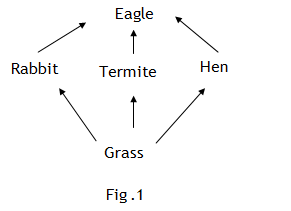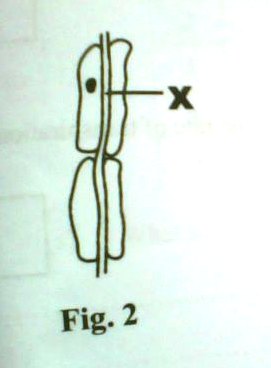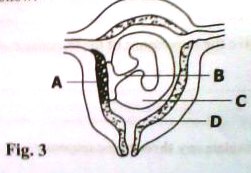SECTION A
Answer all questions in this section. Write the letter representing the correct answer to each question in the boxes provided.
1. Which one of the following is a characteristic of a monocotyledonous stem?
A. Scattered vascular bundles.
B. Vascular bundles arranged in a ring
C. Vascular bundles have cambium
D. Have distinct pith.
2. The lipase enzyme catalyses the breakdown of
A. fats
B. proteins
C. maltose
D. sucrose
3. The kind of solution which would make a fully turgid plant cell placed in it to shrink is
A. more dilute than the cell content
B. of the same concentration as the cell content
C. more concentrated than the cell content
D. less in quantity than the cell sap
4. Which one of the following features is common to both class insecta and class arachinda?
A. having three main body divisions
B. Possession of an exoskeleton
C. Having three pairs of legs
D. Possession of antennae
5. Which one of the following vectors transmits yellow fever?
A. Female Anopheles mosquito
B. Culex mosquito
C. Tsetse fly
D. Aedes mosquito
6. Which one of the following is a benefit of using manure?
A. Preventing soil erosion
B. Improving crumb structure of soil
C. Reducing population of harmful organisms in soil
D. Maintaining adequate soil cover
7. Figure 1 shows a food web

Which one of the following organisms in figure 1 is a secondary consumer?
A. Hen
B. Grass
C. Eagle
D. Termite
8. Which one of the following pairs is made up for only major elements in plant nutrition?
A. Magnesium and Calcium
B. Molybdenum and Iodine
C. Boron and Chlorine
D. Manganese and Copper
9. Which of the following blood transfusion will lead to agglutination?
|
Donor’s blood group |
Recipient’s blood group |
|
|
A. |
AB |
O |
|
B. |
B |
AB |
|
C. |
A |
A |
|
D. |
O |
B |
10. During expiration in a bony fish, the operculum is forced open when the
A. floor of the buccal cavity is lowered
B. volume of the buccal cavity increases
C. pressure in the buccal cavity decreases
D. pressure in the buccal cavity increases
11. In which part of the nephron does reabsorption of sugars take place?
A. Distal convoluted tubule
B. Loop of Henle
C. Proximal convoluted tubule
D. Collecting duct
12. Where is the image of a far object formed in the eye of a short-sighted person?
A. On the chorid
B. Behind the retina
C. In front of the retina
D. On the blind spot
13. A plotted plant placed horizontally on a rotating klinostat continues to grow in a horizontal direction because auxins
A. migrate to the tip of the shoot
B. are uniformly distributed in the shoot
C. migrate the dark side of the shoot
D. migrate to the illuminated side of the shoot
14. Which one of the following characteristics can be used to identify a cervical vertebra? Presence of
A. small neural canal and metapophysis
B. long neural spine and large centrum
C. small transverse processes and narrow neural spine
D. vertebraterial canals and shoty neural spine
15. Which one of the following characteristics of flowers encourages cross pollination
A. Being unisexual
B. Being bisexual
C. Anthers above the stigma
D. Stamens and pistil remain enclosed
16. Which one of the following human characteristics exhibits discontinuous variation?
A. Height
B. Blood groups
C. Weight
D. Skin color
17. The function of sodium hydrogen carbonate in an experiment to show that carbon dioxide is necessary for photosynthesis is to;
A. absorb carbon dioxide
B. reduce oxygen
C. produce water
D. produce carbon dioxide
18. What is the effect of rapid elongation of the hypocotyls during seed germination?
A. Cotyledon remains underground
B. Plumule grows straight out of the gorund
C. Cotyledon is carried above ground
D. Hypocotyl straightens
19. A normal man married to a normal woman had a haemophiliac child. Suggest the sex of the child with a reason.
A. Female, because males do not suffer from haemophilia.
B. Male, because he inherited the trait from the carrier father.
C. Female, because she inherited the trait from the normal father
D. Male, because he inherited the trait from the carrier mother.
20. Which of the following pairs are correct products of aerobic respiration in both plants and animals?
A. Lactic acid and water
B. Alcohol and carbon dioxide
C. Carbon dioxide and water
D. Lactic acid and carbon dioxide
21. Which one of the following responses are likely to occur in the human body when environmental temperature increases?
A. Vasodilation
B. Shivering
C. Contraction of the erector pili muscle
D. Increased metabolism
22. Figure 2 represents part of a sensory neurone
What is the function of the part marked X?It
A. is the pathway of the nerve impulse
B. produces the myelin sheath
C. speeds up impulse transmission
D. carries impulse to the cell body
23. Which one of the following is a function of oestrogen in humans?
A. Causes Graafian follicle to develop
B. Repairs the uterine lining
C. Causes degeneration of the corpus luteum
D. Causes ovulation
24. Which one of the following bones is found in the human fore limb?
A. Their innermost layer is smooth
B. They have thick and elastic walls
C. They have wide lumen
D. Their walls are thin and inelastic
25. Which one of the following bones is found in the human fore limb?
A. Fibula
B. Femur
C. Tibia
D. Ulna
26. Sperms in the mammalian male reproductive system are stored in the
A. uretha
B. epididymis
C. seminiferous tubule
D. prostate gland
27. Which one of the following characteristics belongs to a fruit dispersed by water?
A. Hooks
B. Wings
C. Fibrous mesocarp
D. Pericarp with line of weakness
28. Which one of the following conditions increases the rate of transpiration?
A. High temperature
B. Low light intensity
C. Still air
D. High atmospheric pressure
29. The association between nitrogen fixing bacteria in the root nodules and the leguminous plant can best be described as
A. mutualism
B. commensalism
C. parasitism
D. competition
30. All the following conditions result from deficiency of vitamins of the B group except
A. beriberi
B. pellagra
C. pernicious anaemia
D. failure of blood to clot
SECTION B
Answer all questions in this section.
31. In an experiment, two glass tubes were filled with different soil sample A and B. The glass tubes were places in a basin of water and left to stand for 5 days.
The rise of water column in each soil sample was measured and recorded each day for 5 days as shown in table 1
Table 1: Rise of water column in soil samples A and B
|
Days |
Rise of water column (cm) |
|
|
Soil sample A |
Soil sample B |
|
|
1 |
12 |
20 |
|
2 |
16 |
24 |
|
3 |
32 |
26 |
|
4 |
37 |
27 |
|
5 |
38 |
27 |
a) What soil factor was being investigated?
b) Using the results in table 1, plot on a graph showing the rise of water in the two soil samples A and B.
c) Describe the rise of water through soil samples A and B as shown on the graph.
d) Explain the differences in the water rise through the two soil samples.
e) Using the rise of water column on the graph for day 1, suggest with a reason the type of soil samples A and B
f) What is the importance of the factors being investigated in plants?
32. Figure 3 is a diagram showing the uterus of a pregnant woman. Study it and answer questions that follow:
a) Name the parts labeled A, B, C and D
b) Give any one function for each of the each of the parts labeled A,B,C and D
c) State any two adaptations of part A for its function
d) Using letter X, indicate on the diagram the part that develops into a baby
e) Name the hormone that enables part D to be efficient during pregnancy
33.a) What kind of response is demonstrated when maggots placed in a choice chamber move towards the wet part?
b) Give the importance of the response stated in (a) to the maggots
c) Explain any three tropic responses.
d) Explain one significance of tropic responses in;
i) providing support to plants
ii) aiding photosynthesis
SECTION C
Answer any two questions from this section.
34. a) Describe the different types of immunity in humans
b) Explain the role of blood in body defense
c) Give any five ways in which the body immunity can be weakened.
35. a) How is light from a nearby object focused on the retina of a human eye?
b) i) Explain why a long sighted person cannot see near objects clearly
ii) Using a diagram, explain how long sightedness can be corrected.
36.a) Give the meaning of each of the following terms
i) Parasitism
ii) Symbiosis
b) How is a tapeworm adapted to its parasitic mode of life?
c) Outline three control measures to prevent the spread of tapeworms in humans
37. a) Describe how leaves of green plants are suited for photosynthesis.
b) Explain how each of the following substances is utilized by a plant:
i) Water absorbed
ii) Food manufactured
END


